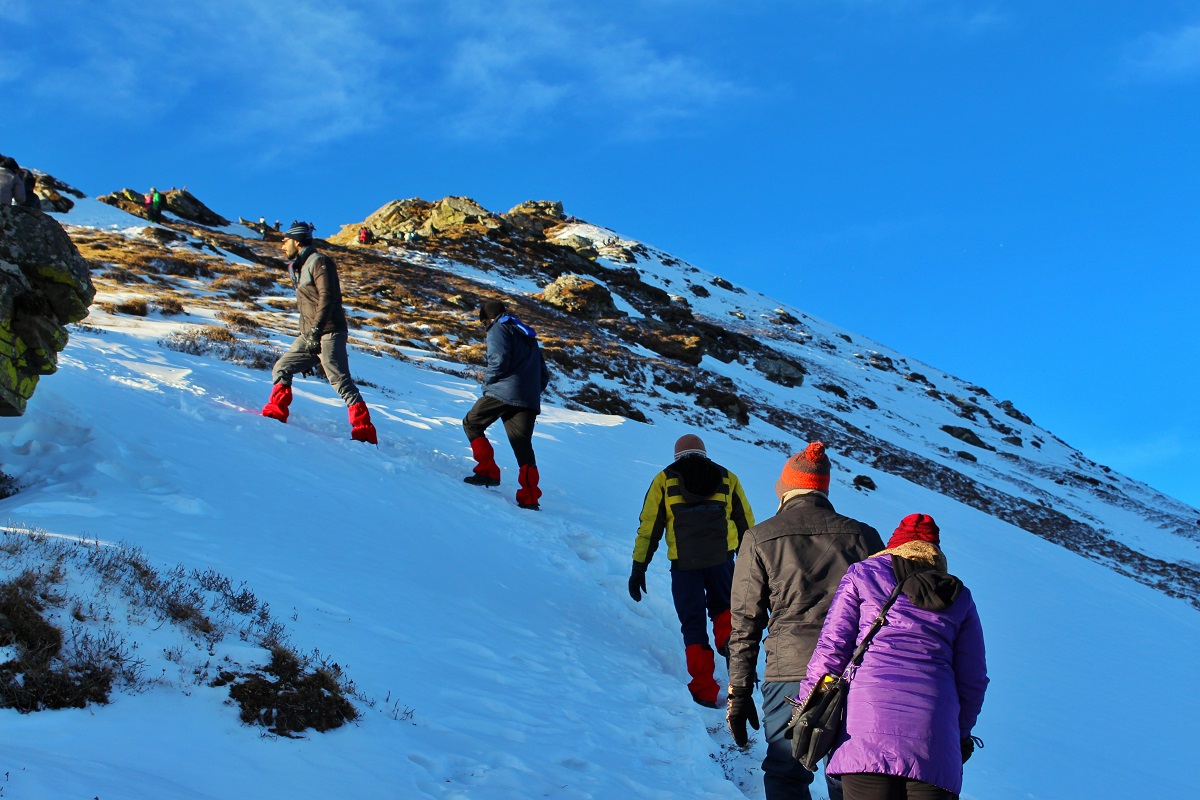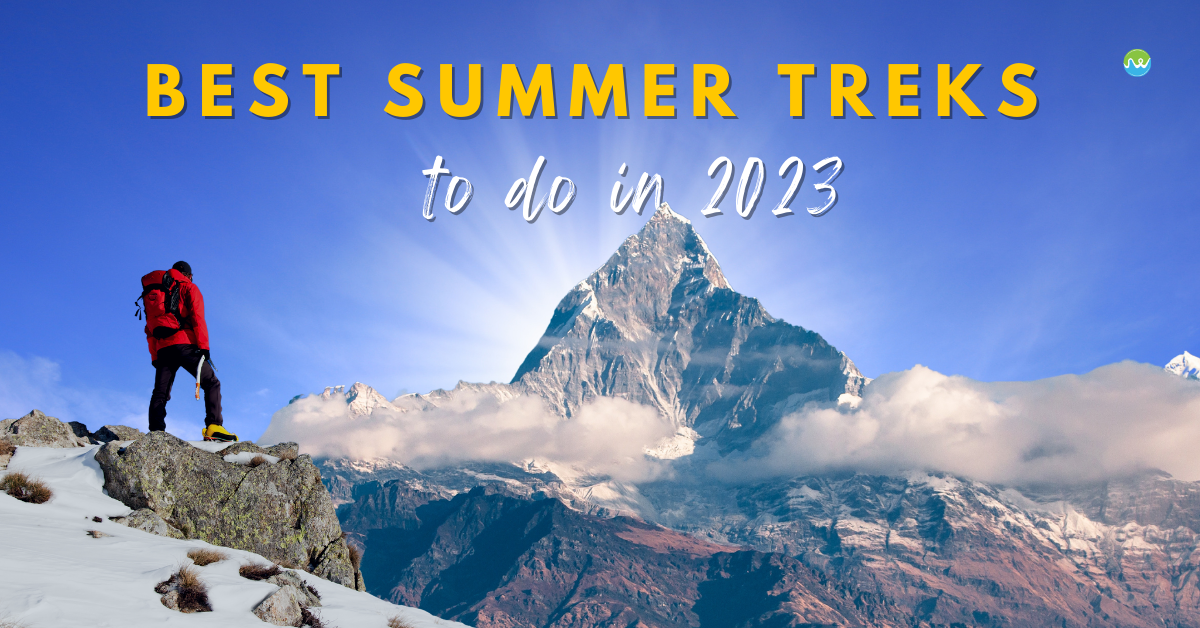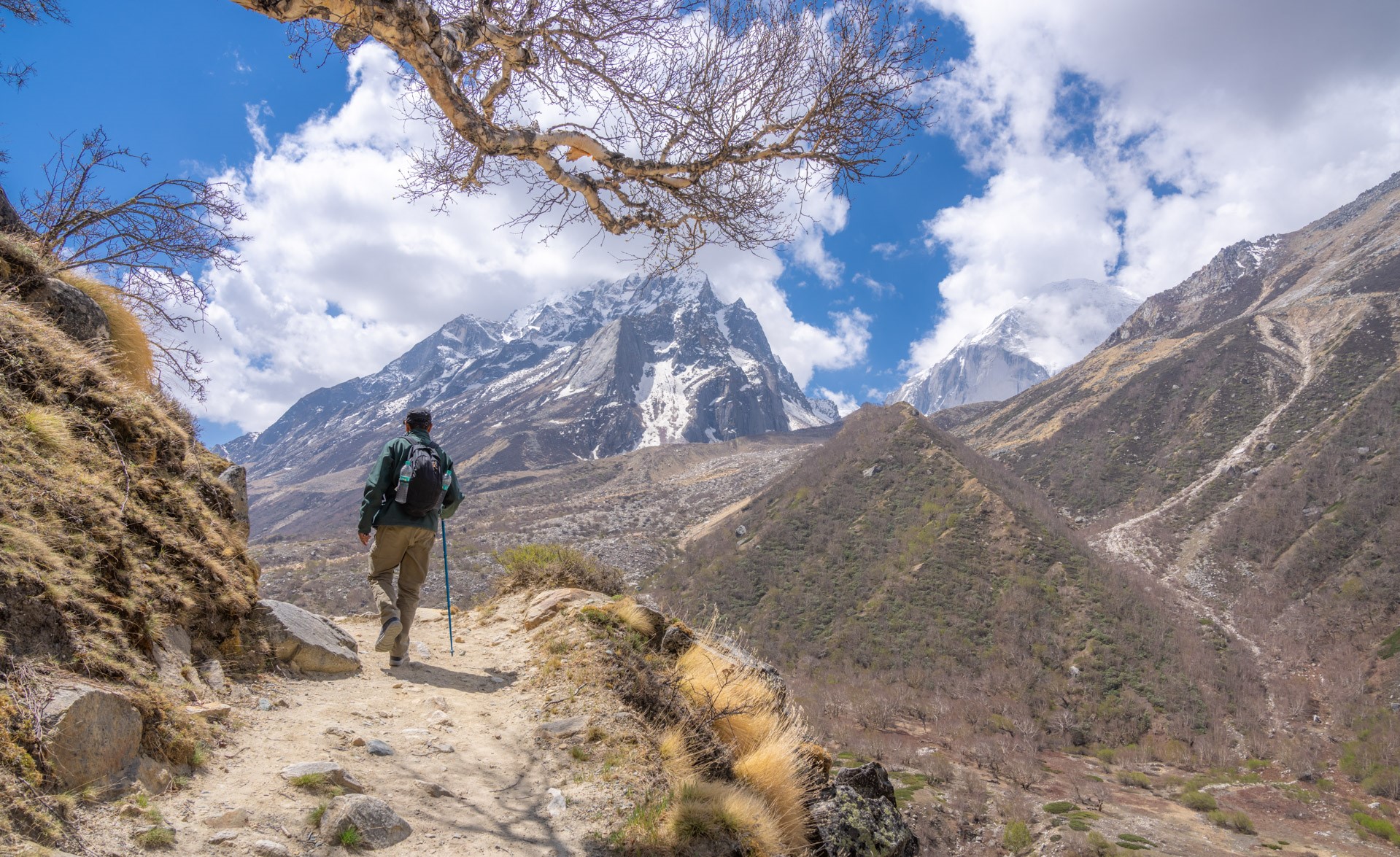Pangarchulla Peak Trek
Details
Inclusions
Safe Travel
Flexible Cancellation
Easy EMI
Certified Captains
24/7 Support
Overview
At a staggering height of 15,010 Ft, the Pangarchulla Peak trek, with its breathtaking views of the Garhwal Himalayan peaks, Nanda Devi, Chaukhamba, and Hati-Ghori to name a few, is one of the best treks for both novices as well as experienced trekkers. The path is initially lined with rocks but gradually ascends into a picturesque landscape that is a blend of green meadows, majestic mountains, and quaint villages consisting of wooden houses. Also known as the Chimney peak, it adds more charm to the Lord Curzon circuit of trekking trails with its snow-covered slopes and diverse flora and fauna. The trails of the Pangarchulla peak trek follow the same paths of pilgrimage that have the footprints of devotees who embark on a spiritual journey from Haridwar to Joshimath. Although the Pangarchulla trek remains accessible throughout the year, it's when the ridges and surrounding land are covered in snow is when the experience becomes ten times better. Although during summers, the view is no less charming. The vast expanse of green land speckled with the blooming colors of spring make it truly mesmerizing. The oak, blue pine, and Bhojpatra trees adorn the trail and provide shelter to a variety of wildlife, like the black deer and Himalayan Tahr which you can spot if you are lucky. The Pangarchulla trek falls in the moderate level category which means even though it gives you the adrenaline rush that many adventure enthusiasts seek, it also becomes hard to keep up with the demanding nature of the trek but it rewards the bold and determined with the feeling of triumph when they reach the summit. The most exciting part of any trek is no doubt the end when you realize that all the hardships you faced bore fruit that was not only sweet but worth it all. However, it's the trail and walking upon it that makes reaching the top feel so fulfilling. The trail of Pangarchulla peak starts from the village of Dhak. The peace that you witness with the slant-roofed houses and streams of water falling behind is quite unmatched. You will witness cattle grazing and even meet some Himalayan shepherds along with locals but as you gradually ascend upwards, the traces of civilization will start to fade and so will the brown terrains, giving way to thick forests with Garhwal Himalayan peaks beckoning you closer from behind.
The more distance you cover on the trekking trail to Pangarchulla peak, the more traces of green canopies will come into view, with the golden oak trees and blue pines. For a moment, you will lose sight of the mountains as you trek deeper into the forests. During the summer and spring seasons, you would find bloomed rhododendrons and in winter, a thick blanket of snow stretched like a carpet beneath your feet. It depends on what kind of landscapes fascinate you, if you are a snow fanatic and can overcome the harsh breeze then you can mount your flag on the summit of Pangarchulla during winters but if you are someone who just wants to enjoy the serenity that nature brings them then the best time to do the Pangarchulla trek would be from March to May. The golden sunrises and tangerine sunsets while you embark on the Pangarchulla trek are to die for but the sight of the majestic Himalayan peaks like Mt. Kamet, Mana Parvat, Garud, Trishul, and Dronagiri is what makes you feel as if you are on top of the world.
As you follow the Lord Curzon trail, traversing through the meadows that offer a gateway to Pangarchulla, you must be well-equipped with water because the more you travel upwards, the more scarce your resources become. But once you have reached the ridge that has Chaukhamba massif adorning it, all your fatigue will leave you in an instant. The Pangarchulla main peak will beckon you closer from here and it depends on you whether you wish to go forward. If you continue on the path, after a few hundred meters, the knife ridge begins. It's crucial to reach the summit early in the morning because as the sun rises, the snow begins to melt making the slope extremely slippery and risky. Finally, after conquering all your fears and hardships, you would reach the summit point and witness the glory of Garhwal Himalayan peaks in the form of a 360 view with Nanda Ghunti on your left, Chaukhamba on your right with all its terrains clearer than ever before. Once you have relished the experience of reaching the summit of Pangarchulla peak, we will head back to basecamp. The reason why the Pangarchulla peak trek is one of the best winter treks that you must do is that it embodies the grandeur of the great Himalayas perfectly. You get to see different peaks, traverse through forests and meadows, come across streams of Himalayan water, and be acquainted with the flora and fauna the Himalayas are home to. A benefit of doing this trek is that if you have enough time on your hands then you can cover Kuari Pass as well as Auli, the Himalayan ski resort while on the Pangarchulla peak trek.
In a nutshell, the Pangarchulla trek is one of the best treks that you can do in the Himalayan region and as it's one of the underrated treks in India, it provides you both thrill as we as solitude.
Gallery





Itinerary
Day
Rishikesh to Joshimath (254 Kms, 10 Hrs Drive)
Day
Drive from Joshimath/Pipalkoti to Tugasi (14 Kms, 45 Mins Drive) | Trek to Guling (4 Kms, 5 Hrs)
Day
Trek from Guling to Khullara (6 Kms, 7 Hrs)
Day
Trek to Pangarchulla Summit | Back to Khullara (14 Kms, 12 Hrs)
Day
Trek from Khullara to Tugasi (10 Kms, 6 Hrs) | Drive to Joshimath/Pipalkoti (14 Kms, 45 Mins Drive)
Day
Drive from Joshimath to Rishikesh (254 Kms, 10 Hours Drive) | End of tour
Age Limit (Trip Wise)
Weekend
Getaways
18-38
Himalayan
Treks
18-48
Backpacking
Trips
18-40
Biking
Trips
18-45
Customized
Trips
No Limit
Inclusions & Exclusions
| Inclusions | Exclusions |
Accommodation: 2 Nights in a Hotel / Homestay in Joshimath on a triple-sharing basis. 3 Nights Tented Accommodation on a triple sharing basis. Transportation: Surface transfer from Rishikesh - Joshimath - Rishikesh by Sumo / Bolero / Tempo Traveler - Non A/c (Depending on the number of travelers). Meals: All vegetarian meals from day 1st Dinner to day 6th Morning Tea. Snacks: Morning / Evening Tea / Coffee with light snacks and soup while on the trek. Camping logistics: Tent, Sleeping bags, Mattresses, Dining tent. Trek Leader: Qualified and Experienced Trek leader and support staff. Permits: All necessary fees and permits. Trekking Equipment: Gaiters, Micro Spikes, and Rope if required. Safety Equipment: Basic First Aid kit with Oximeter and Oxygen Cylinder. Guide ratio: 1:10 Others : Cloak Room facility available at base camp for extra luggage. | 5% GST Any expenses of personal nature. Meals during transit. Any insurance of any kind. Any fees and permits (for non-Indians). Unscheduled delay due to landslide. Cost Escalation due to “ Force Majeure and Evacuation charges”. Anything not mentioned explicitly in the above program. Note: You can apply for travel insurance before the trek. Bag offloading cost is Rs 1400 (maximum weight should not be more than 10 kg) |
Cancellation Policy
| Upto 21 days | 20-15 days | 14-8 days | 7-0 days | |
| Batch Shifting | ||||
| Cancellation Charge | Free Cancellation | 25% of the Trip Amount | 50% of the Trip Amount | 100% of the Trip Amount |
| Booking Amount | Refunded in mode of Credit Note | Adjusted in Refund Deduction | Adjusted in Refund Deduction | No Refund |
| Remaining Amount | Full Refund (minus) booking amount | Refund (minus) 25% of the trip amount | Refund (minus) 50% of the trip amount | No Refund |
Credit Note :
The Booking Amount will be credited to your JW Profile which can be accessed by logging in to the website through your Phone Number & OTP. Credit Notes issued have no date of expiry and can be used entirely in any of your future trips.
GST :
Any GST charged on any transaction will not be refunded.
Pending Refund :
Any refund pending on your booking will be credited to the same mode of payment through which you paid in 5-7 working days.
Partial Refund :
Any case in which a partial refund will be issued will be calculated after deducting the Booking Amount and Cancellation Charges depending on the time of Cancellation.
Remaining Amount :
Will be calculated on the amount paid over and above the booking amount.
Bypass Policy :
Any and all Cancellation Policies are superseded by the Emergency Case Cancellation Policy in case of situations such as war, pandemics, force majeure, or similar extraordinary events affecting the tour region.
Payment Policy
| Upto 21 days | 21-15 days | 14-08 days | 07-03 days | |
|---|---|---|---|---|
| Booking Amount | ||||
| 50% Payment | Optional | Compulsory | ||
| 75% Payment | Optional | Optional | Compulsory | |
| 100% Payment | Optional | Optional | Optional | Compulsory |
FAQs
Are mobile networks available on the Pangarchulla Peak Trek?
There is decent network coverage at the base camp for Airtel, and Jio users. However, you won’t get connectivity on the summit and you’ll face issues with your network on your trek as well.
What will be the type of accommodation for the Pangarchulla Peak Trek?
There will be hotel accommodations at Joshimath which is the basecamp. On the trek, there would be tented accommodations on a sharing basis.
How to reach the basecamp for Pangarchulla Peak Trek?
The basecamp for the Pangarchulla Peak Trek is Joshimath which is approximately 254 Kilometers away from Dehradun. It takes a 10 hour drive to reach Joshimath. After which the trek starts from Tugasi.
What is the best itinerary for the Pangarchulla Peak Trek?
The Pangarchulla Trek starts from Joshimath which is the base camp for this particular trek. Starting from Joshimath, the trek traverses through tiny hamlets like Tugasi, Guling, and Khullara finally taking you to the Pangarchulla summit.
What is the height of the Pangarchulla Peak Trek?
Pangarchulla Peak is nestled at an altitude of 15,010 ft.
What is the best time to do the Pangarchulla Peak Trek?
The best time to do the Pangarchulla Trek is the Post-Monsoon Season. The Himalayas receive extreme snowfall in winter which makes it tricky to navigate the trail and slopes become slippery in the monsoon season. Pangarchulla is one of the few treks that have a small window for when it is accessible.
How long is the Pangarchulla Peak Trek?
The Pangarchulla Trek stretches up to a distance of 34 Kilometers.
Where is the Pangarchulla Peak located?
The Pangarchulla peak is nestled in the Garhwal Himalayas. The trek is located in the Chamoli district of Uttarakhand.
How difficult is the Pangarchulla Peak Trek?
The Pangarchulla Peak Trek comes under the difficult category when it comes to the difficulty levels of Himalayan Treks. The high altitude, steep ascents, boulders, and sedimentation make this trek a tricky one.
Everything you need to know about Pangarchulla Peak Trek
Pangarchulla Peak Trek is a challenging summit climb in the Garhwal region of Uttarakhand, India, situated in the Nanda Devi National Park. This trek offers a power-packed and thrilling adventure. Traversing the Lord Curzon circuit in the Garhwal Himalayas, the legendary Pangarchulla peak stands tall, beckoning adventurers with its majestic presence. Rising to an impressive height of 14,700 ft, this peak provides a challenging yet non-technical climb for mountaineering enthusiasts. While the trek in Uttarakhand is open all year round, it is during the winter months when the landscape is transformed by a blanket of snow, creating an unparalleled experience. For those seeking an adrenaline rush and a true test of courage, embarking on this winter journey is a must.
Over the course of 6 days, the trek will lead you through the sacred lands of Uttarakhand, from the spiritual town of Rishikesh to the base camp at Pipalkoti. Starting from Tugashi village, the trail winds its way up rocky paths, revealing picturesque cliffside villages with terraced fields and traditional houses, before opening up to lush meadows surrounded by the iconic peaks of the Garhwal Himalayas. The prominent peaks of Nanda Devi, Chaukhamba, Hati-Ghori, and Barmal grace the horizon, guiding you towards the ultimate destination of Pangarchulla. As part of the Nanda Devi Sanctuary, the trail offers uninterrupted views of these revered peaks, culminating in a breathtaking summit experience with glistening snow vistas.
Pangarchulla presents a moderate-grade trek that requires a certain level of physical fitness to fully appreciate the journey. Upon reaching the summit, one is rewarded with breathtaking 360° views of prominent Himalayan peaks such as Mt. Nanda Devi (7,816 m), Hathi Parat (6,727 m), Ghodi Parvat (6,708 m), Kamet (7,756 m), and Dronagiri (7,066 m).
The optimal time to embark on the Pangarchulla Trek is during the spring season, when the weather is typically sunny during the day with mildly cold evenings. However, temperatures plummet significantly after sunset. Daytime temperatures hover around 15°C at Pangarchulla, while nighttime temperatures can dip as low as -5°C or even lower. It is advisable to pack ample warm layers as the nights can be quite chilly. Additionally, unexpected showers may occur in Pangarchulla, so it is essential to be prepared for such occurrences. The Pangarchulla Peak Trek is a challenging summit climb, which takes you through some of the most beautiful scenic trails and paths in the Garhwal region of Uttarakhand, India. The trek is known for its summit climb, which is a challenging yet rewarding experience. The trek requires trekkers to have a high level of fitness and prior experience of high-altitude treks. With proper preparation and following the trekking tips, the Pangarchulla Peak Trek can be a memorable and rewarding experience.
How to reach Pangarchulla Trek
To reach the Pangarchulla trek, you can use the following modes of transportation:
By Flight: The nearest airport is Jolly Grant Airport in Dehradun, which is approximately 290 km from Joshimath. You can take a flight from major cities like Delhi, Mumbai, Kolkata, and Bangalore to Dehradun. From Dehradun, you can hire a taxi or take a shared taxi to reach Joshimath, which is approximately 260 km away. The journey takes around 7-8 hours.
By Train: The nearest railway station is Rishikesh, which is approximately 245 km from Joshimath. You can take a train from major cities like Delhi, Mumbai, Kolkata, and Bangalore to Rishikesh. From Rishikesh, you can hire a taxi or take a shared taxi to reach Joshimath, which is approximately 260 km away. The journey takes around 7-8 hours.
By Bus: You can take a bus from major cities like Delhi, Mumbai, Kolkata, and Bangalore to Rishikesh or Dehradun. From Rishikesh or Dehradun, you can hire a taxi or take a shared taxi to reach Joshimath, which is approximately 260 km away. The journey takes around 7-8 hours.
Best time to do Pangarchulla Trek
The best time to visit Pangarchulla is during the spring months of April to June and the post-monsoon period from September to November. During these times, the weather is pleasant, the skies are clear, and the valleys come alive with different shades of nature. Spring offers an excellent opportunity to trek with melting snow, blooming flora, and clear skies, while the post-monsoon period provides a dry and pleasant climate with changing forest colors and accumulating snow on the peak, creating a picturesque setting for snow lovers.
Highlights of Pangarchulla Trek
• Diverse Flora and Fauna - As you traverse the trail before reaching the snowline, you will be greeted by a vibrant display of crimson rhododendrons. The path will be adorned with a variety of trees such as Oaks, silver birch, blue pine, and Bhojpatra - known for its bark used in making papyrus. Keep an eye out for the musk deer, black bear, and Himalayan Tahr which are commonly spotted in this region.
• A Challenging Ridge Climb on Summit Day - The final ascent to the peak involves navigating a steep ridge, testing your endurance but rewarding you with a sense of accomplishment. The thrill of adrenaline rushes through you as you conquer the arduous climb, with the snow-covered trail enhancing the exhilarating experience of exploration.
• Safe Snow-Covered Slopes for Adventure - One of the defining features of your winter expedition to Pangarchulla Peak is the presence of snow. The slopes, coated in powdery snow during the last stretch of the climb, offer a relatively safe ascent without the fear of a fatal fall, thanks to the cushioning effect it provides. These gently sloping inclines resemble those of skiing slopes, making it an ideal playground for those with skiing experience to revel in the snowy wonders of the Himalayas without the risk of perilous mishaps.
posts
Instagram Images
REVIEWS
What our Clients Say About Us
blogs
Our Blogs
TRIPS
Related Trips

B-42, 2nd Floor, Tower- B, The Corenthum, Block A, Sector 62, Noida, Uttar Pradesh 201301
© 2015-2025 JustWravel Pvt. Ltd.












